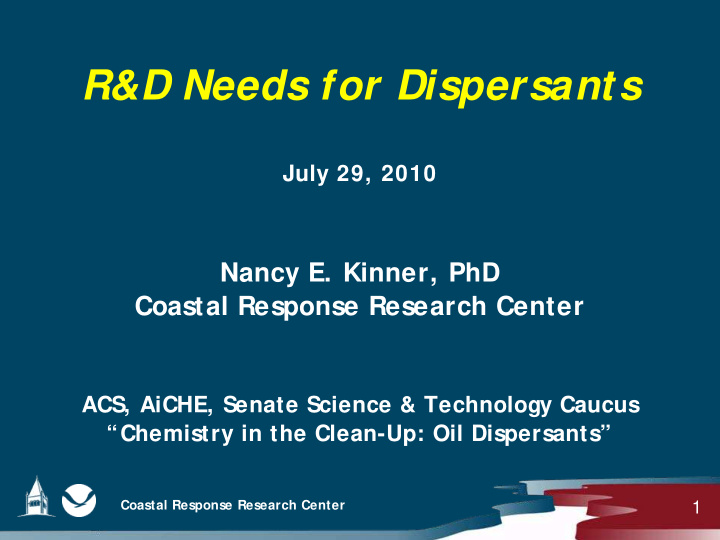



R&D Needs for Dispersants July 29, 2010 Nancy E. Kinner, PhD Coastal Response Research Center ACS, AiCHE, Senate Science & Technology Caucus “Chemistry in the Clean-Up: Oil Dispersants” Coastal Response Research Center 1
CAVEATS • Today = Unique R&D Issues Deepwater Horizon (DWH) • Extensive List of Dispersants R&D Needs Identified Before Deepwater Horizon Spill • National Research Council: Oil Spill Dispersants: Efficacy and Effects (May 2005) • Dispersants Working Group: R&D Needs for Making Decisions Regarding Dispersing Oil (Sept 2005) • Dispersants Working Group: Dispersed Oil Research Data (Present) • R&D Coordination: Dispersants Working Group Coastal Response Research Center 2
DEEPWATER HORIZON SOURCES (TODAY’S PRESENTATION) • Deepwater Horizon Dispersants Use Meeting Report • (May 2010) • Deepwater Horizon Dispersants Data Webinar • (July 2010) Coastal Response Research Center 3
R&D ISSUES – DEEPWATER HORIZON LARGE VOLUME • Large Volume Applied: 1.84M Gallons Total • 1.07M gallons surface • 0.77M subsurface • IXTOC = 2.5M gallons • Continuous Application Over Many Days • Long-term exposure Coastal Response Research Center 4
R&D ISSUES – DEEPWATER HORIZON SUBSURFACE INJECTION • Deepwater Dispersant Use • Injection in turbulent plume • Cold water (~4 0 C) in deep GOM • Warm oil (~100 0 C) exiting well • Pressure high (2200 psi at 5000 ft, oil exiting under pressure too) Coastal Response Research Center 5
R&D ISSUES – DEEPWATER HORIZON EFFICACY • Dispersant: Oil Ratio • Dispersant Types • Oil Flow Rate Estimates • Subsurface Mixing Energy Coastal Response Research Center 6
R&D ISSUES – DEEPWATER HORIZON EFFECTIVENESS • Monitoring Techniques: • Conventional = Visual + Fluorescence • Gas Chromatography / Mass Spectrometer • Acoustics • Particle Counter (LISST) • Ocean Observing Systems (e.g., gliders) Coastal Response Research Center 7
R&D ISSUES – DEEPWATER HORIZON FATE & BEHAVIOR • Fate and Behavior: (Chemical Dispersants vs. Natural Dispersion) • 3D behavior from deepwater upward • Dispersion • Dissolution • Biodegradation • Sinking (?) • Dispersability of weathered oil • 3D models to predict where, when, how much • Offshore and onshore model links Coastal Response Research Center 8
R&D ISSUES – DEEPWATER HORIZON BIOLOGICAL EFFECTS • Air vs. Water Exposure • Marine Biota (Surface & Deepwater) and Humans • Acute vs. Chronic • Cytotoxicity, Endocrine Disrupters • Realistic Exposures • Time • Concentration • Seafood Safety • Dispersants in Seafood • Dispersed oil Coastal Response Research Center 9
R&D ISSUES – DEEPWATER HORIZON OTHER TOPICS • Dispersant Discontinuance Criteria • Role of Consensus Ecological Risk Assessment • Dispersant Database • Build on LUMCON (LA Universities Marine Consortium) • Biological Threshold Database • Links to Previous Studies Coastal Response Research Center 10
Coastal Response Research Center Website www.crrc.unh.edu Coastal Response Research Center 11
Recommend
More recommend